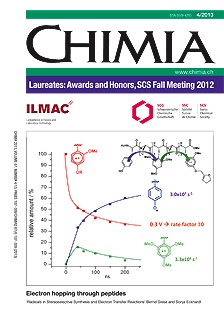Bioinspired Surfaces Against Bacterial Infections
DOI:
https://doi.org/10.2533/chimia.2013.275Keywords:
Antibacterial, Antifouling, Catechols, Mussel adhesive proteins, Quorum sensingAbstract
Bioactive surfaces that can prevent bacterial infections are of great interest since device-related infections represent an emerging and major threat to our health-care system. For that purpose, dopamine and its derivatives have been shown to provide an exceptionally facile method for the immobilization of bioactive compounds on metal oxide surfaces through an operationally simple dip-and-rinse procedure. Based on this method, three different coating strategies for the assembly of antifouling, antibacterial, and quorum sensing modulating surfaces have been established. The anachelin chromophore and nitro-dopamine proved to be very suitable anchoring moieties as they possess better oxidative stability and binding efficiency compared to dopamine itself. Furthermore, adsorbed bioactive hybrids were shown to be stable and recycling of the surfaces could be achieved. These examples clearly demonstrate the efficiency of this approach for the production of active surfaces, such as in biomedical devices.Downloads
Published
2013-04-24
Issue
Section
Scientific Articles
License
Copyright (c) 2013 Swiss Chemical Society

This work is licensed under a Creative Commons Attribution-NonCommercial 4.0 International License.
How to Cite
[1]
J. Gomes, A. Grunau, A. K. Lawrence, L. Eberl, K. Gademann, Chimia 2013, 67, 275, DOI: 10.2533/chimia.2013.275.







